Rogers Communications Bundle
Unpacking Rogers Communications: How Does It Thrive?
Rogers Communications is a giant in the Canadian telecom and media sectors, playing a crucial role in how millions connect daily. From its extensive Rogers Communications SWOT Analysis to its diverse service offerings, understanding Rogers is key for anyone invested in the Canadian market. Its impact spans wireless, cable, internet, and media, making it a vital player in the country's economic landscape.
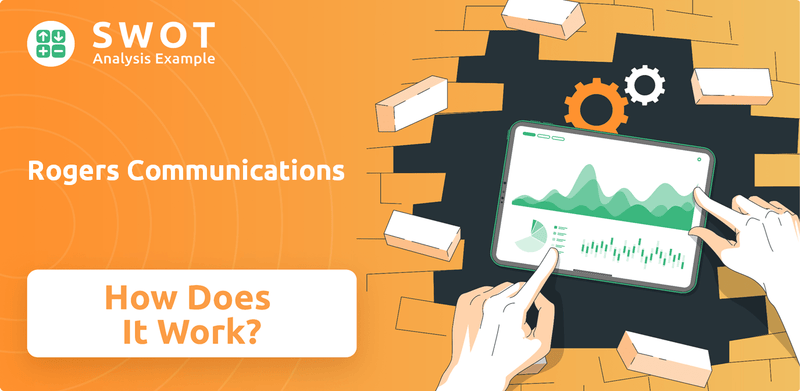
This deep dive will explore the inner workings of Rogers, from its expansive Rogers services to its competitive advantages. We'll examine how the Rogers network functions and generates revenue, offering insights for investors, customers, and industry analysts. Discover the strategies behind this Canadian telecom leader, including its approach to wireless, internet provider services, and content delivery.
What Are the Key Operations Driving Rogers Communications’s Success?
Rogers Communications delivers value through its telecommunications and media services, focusing on consumers and businesses across Canada. Its core offerings include wireless communications, cable television, high-speed internet, and home phone services. These services cater to a wide range of customers, from individual households to large enterprises.
The operational backbone of Rogers involves continuous investment in its network infrastructure, including 5G expansion, and sophisticated customer support systems. The company relies on hybrid fibre-coaxial (HFC) and fibre-to-the-home (FTTH) networks for cable television and internet services. Logistics, sales channels, and customer service are also key components. The integrated approach of offering bundled services enhances customer retention.
Rogers' continuous investment in network upgrades and expansion, particularly in 5G technology, enhances its value proposition by delivering faster speeds and more reliable connectivity. This translates directly into customer benefits and market differentiation. To learn more about the company's strategy, you can read about the Target Market of Rogers Communications.
Rogers is a major wireless provider in Canada, offering a wide array of mobile plans. These plans include various data allowances, talk time, and text messaging options to meet different customer needs. The company continuously invests in its Rogers network to expand coverage and improve speeds.
Rogers provides cable TV packages with a broad selection of channels and on-demand content. Customers can choose from different packages based on their preferences and budget. The company's cable TV services also include advanced features like digital video recording (DVR) and interactive guides.
Rogers offers high-speed internet access, a critical service for modern connectivity. Its internet plans vary in speed and data allowance to suit different usage needs. Rogers Ignite internet review often highlights its speed and reliability.
Rogers provides home phone services, offering reliable voice communication. These services often include features like call waiting, call display, and voicemail. Home phone services remain a valuable option for many customers.
Rogers' operations are multifaceted, encompassing network infrastructure, customer service, and supply chain management. The company's integrated approach, offering bundled services, enhances customer retention. Continuous investment in network upgrades, particularly 5G, boosts its value proposition.
- Network Infrastructure: Ongoing investment in 5G and FTTH.
- Customer Service: Essential for customer satisfaction and loyalty.
- Supply Chain: Managing equipment and technology acquisition.
- Strategic Partnerships: Content agreements and distribution networks.
Rogers Communications SWOT Analysis
- Complete SWOT Breakdown
- Fully Customizable
- Editable in Excel & Word
- Professional Formatting
- Investor-Ready Format
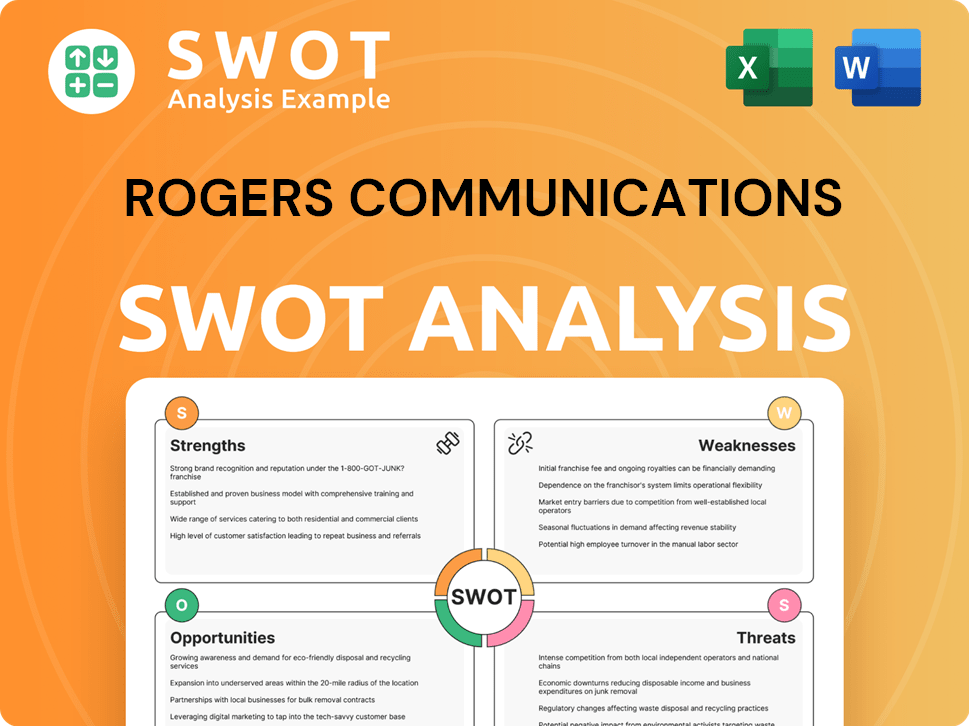
How Does Rogers Communications Make Money?
Understanding how Rogers Communications generates revenue is key to grasping its business model. The company, a major player in the Canadian telecom sector, leverages a diverse range of services to generate income. These services span wireless, cable, and media, each contributing significantly to the company's financial performance.
Rogers' revenue streams are multifaceted, reflecting its wide-ranging service offerings. Wireless services, cable subscriptions, and media activities are the main drivers of revenue. This diversified approach allows Rogers to cater to a broad customer base and mitigate risks associated with reliance on a single service.
In the first quarter of 2024, Rogers reported total revenue of $5.09 billion, marking a 6% year-over-year increase. This growth highlights the company's strong market position and effective monetization strategies. The company's performance in key areas such as wireless, cable, and media demonstrates its ability to adapt to market dynamics and customer demands.
Rogers employs several strategies to monetize its services effectively. These strategies include tiered pricing, bundled services, and cross-selling opportunities. The company also focuses on expanding its high-speed internet offerings and 5G network, recognizing these as key growth areas.
- Tiered Pricing: Rogers offers various plans for wireless and internet, allowing customers to choose based on their needs and budget.
- Bundled Services: Customers who subscribe to multiple services (wireless, internet, and TV) receive discounts, increasing customer loyalty and revenue.
- Cross-Selling: Promoting additional services or upgrades to existing customers is a key strategy.
- Media Segment: Advertising sales are a significant revenue driver, particularly for its television and radio properties.
- 5G Network Expansion: Continuous investment in the 5G network enhances service quality and attracts more subscribers.
The acquisition of Shaw Communications in 2023 has significantly expanded Rogers' footprint, particularly in Western Canada, boosting its cable and internet segments. For more insights into the company's journey, you can explore a Brief History of Rogers Communications.
Rogers Communications PESTLE Analysis
- Covers All 6 PESTLE Categories
- No Research Needed – Save Hours of Work
- Built by Experts, Trusted by Consultants
- Instant Download, Ready to Use
- 100% Editable, Fully Customizable
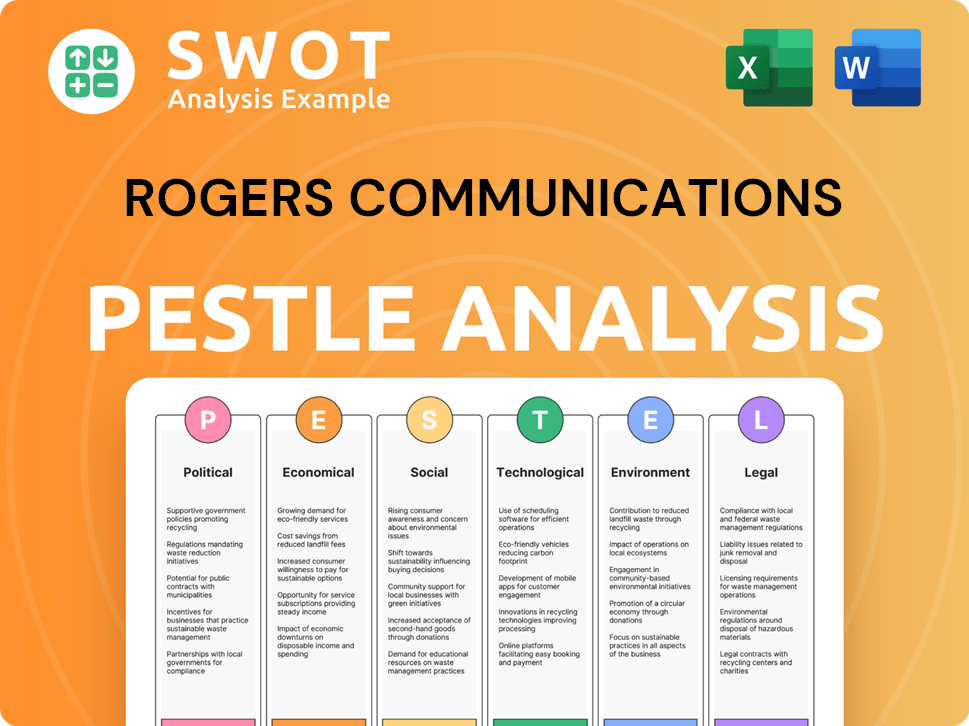
Which Strategic Decisions Have Shaped Rogers Communications’s Business Model?
The evolution of Rogers Communications has been marked by significant strategic shifts and key milestones, shaping its position in the Canadian telecom landscape. A defining moment was the acquisition of Shaw Communications, finalized in April 2023. This move significantly expanded Rogers' footprint, particularly in Western Canada, and bolstered its presence in the cable and internet markets.
The integration of Shaw's assets has been a major operational undertaking, aimed at realizing substantial synergies and enhancing network capabilities. This strategic integration is designed to create a more competitive environment against rivals such as Bell and Telus. Rogers has consistently invested in network upgrades, with significant capital expenditures directed towards its 5G network expansion, crucial for maintaining its competitive edge in the wireless sector.
The company has also faced operational challenges, including network outages, which have prompted increased scrutiny and a focus on network resilience and reliability. Rogers' response has included commitments to improve network stability and enhance customer communication during service disruptions.
The acquisition of Shaw Communications in April 2023 was a pivotal moment, expanding Rogers' reach and market share. Continuous investment in 5G network expansion has been a key focus. Addressing network outages and improving reliability has been a priority.
The Shaw acquisition aimed to create a stronger competitor in the Canadian telecom market. Ongoing network upgrades and technological advancements, particularly in 5G, are vital. Focus on improving customer service and network reliability to mitigate disruptions.
Strong brand recognition and customer loyalty are key advantages. Technological leadership in 5G and fibre deployments provides a superior service experience. Economies of scale and an integrated ecosystem enhance competitiveness.
In the first quarter of 2024, Rogers reported a revenue increase, reflecting the impact of the Shaw acquisition. Capital expenditures remain significant due to network upgrades. The company faces ongoing challenges in integrating Shaw and improving operational efficiency.
Rogers' competitive advantages include strong brand recognition and a loyal customer base, built over decades. Technological leadership, particularly in its 5G rollout and fibre deployments, provides a superior service experience to its customers. Economies of scale, derived from its vast subscriber base and extensive infrastructure, allow for more efficient operations and competitive pricing. To learn more about the company's strategic direction, consider reading about the Growth Strategy of Rogers Communications.
- Strong brand recognition and customer loyalty.
- Technological leadership in 5G and fiber deployments.
- Economies of scale and efficient operations.
- Integrated ecosystem of services enhancing customer retention.
Rogers Communications Business Model Canvas
- Complete 9-Block Business Model Canvas
- Effortlessly Communicate Your Business Strategy
- Investor-Ready BMC Format
- 100% Editable and Customizable
- Clear and Structured Layout
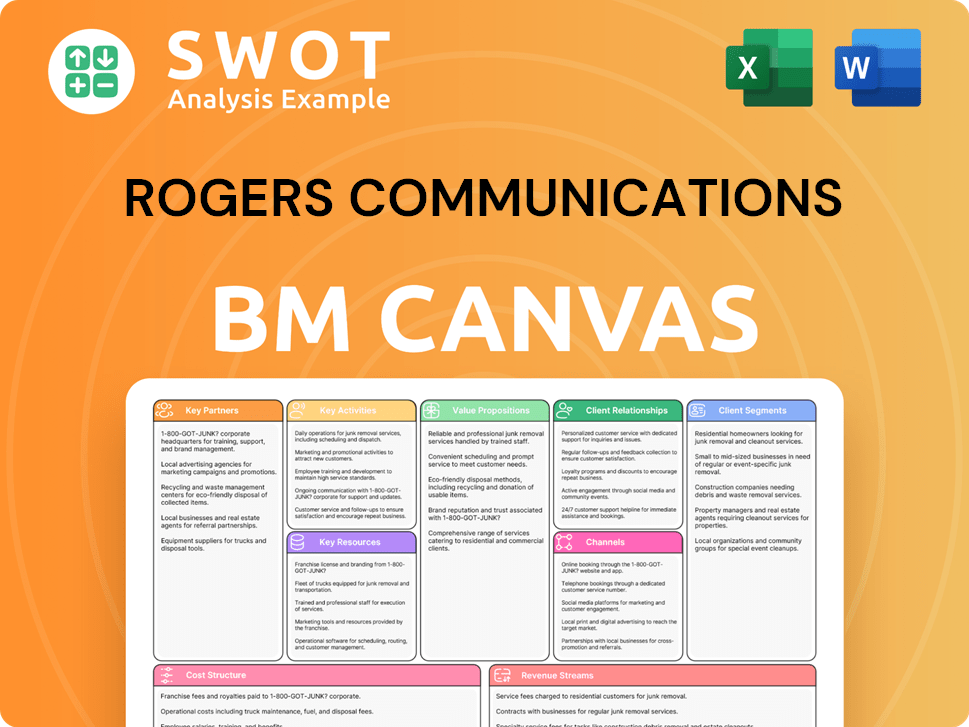
How Is Rogers Communications Positioning Itself for Continued Success?
Within the Canadian telecommunications and media landscape, Rogers Communications holds a prominent position, recognized as one of the 'Big Three' alongside Bell and Telus. It has a substantial market share in wireless, internet, and cable television services across Canada. Rogers' customer loyalty is generally strong, supported by bundled service offerings and ongoing investments in its network. The acquisition of Shaw Communications has further enhanced its market position, particularly in Western Canada, broadening its national reach and improving its competitive standing.
Rogers faces several key risks. Regulatory changes, especially concerning spectrum allocation, network access, and competition, can significantly impact its operations and revenue. Intense competition from Bell and Telus, as well as smaller regional players, necessitates continuous innovation and competitive pricing strategies. Technological disruption, such as the emergence of new communication technologies or over-the-top (OTT) content providers, could alter consumer preferences and revenue streams.
As a major Canadian telecom player, Rogers is a leading wireless provider and internet provider. It competes directly with Bell and Telus, holding a significant portion of the market share. The acquisition of Shaw Communications has boosted its presence, particularly in Western Canada, strengthening its national reach.
Rogers faces regulatory challenges, including spectrum allocation and competition. Intense competition from Bell and Telus, along with smaller players, requires constant innovation. Technological advancements and changing consumer preferences, such as the shift to streaming services, pose ongoing challenges.
Rogers is focused on integrating Shaw Communications and expanding its 5G network. The company is committed to enhancing customer experience and exploring new revenue streams. Rogers plans to leverage its integrated services and advanced networks to adapt to the evolving digital landscape.
Key initiatives include the full integration of Shaw Communications, investments in 5G standalone networks, and exploring fixed wireless access (FWA) and smart home technologies. The company is focused on expanding network coverage and capacity, as well as exploring new opportunities in the digital space.
Rogers' future growth relies on integrating Shaw, expanding its 5G network, and enhancing customer experience. The company is also exploring new revenue opportunities in emerging technologies to stay competitive. For a deeper dive into Rogers' growth strategy, consider reading about the Growth Strategy of Rogers Communications.
- Focus on 5G expansion and network upgrades to improve Rogers services.
- Integration of Shaw Communications to enhance market reach and operational efficiency.
- Development of new services and partnerships in the digital space.
- Continuous investment in Rogers network infrastructure to meet evolving customer demands.
Rogers Communications Porter's Five Forces Analysis
- Covers All 5 Competitive Forces in Detail
- Structured for Consultants, Students, and Founders
- 100% Editable in Microsoft Word & Excel
- Instant Digital Download – Use Immediately
- Compatible with Mac & PC – Fully Unlocked
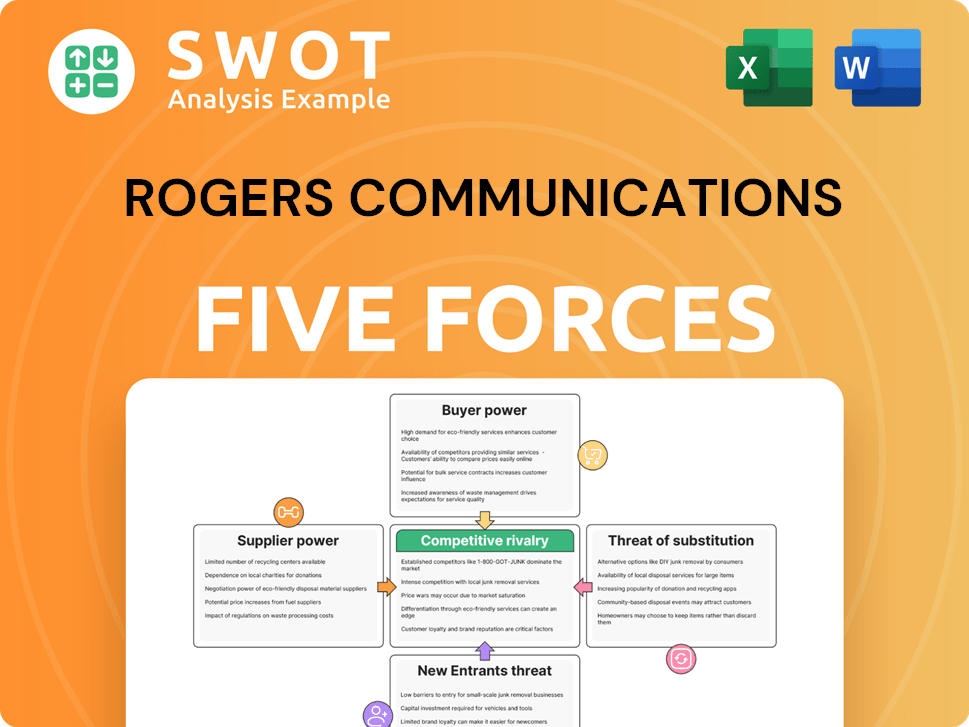
Related Blogs
- What are Mission Vision & Core Values of Rogers Communications Company?
- What is Competitive Landscape of Rogers Communications Company?
- What is Growth Strategy and Future Prospects of Rogers Communications Company?
- What is Sales and Marketing Strategy of Rogers Communications Company?
- What is Brief History of Rogers Communications Company?
- Who Owns Rogers Communications Company?
- What is Customer Demographics and Target Market of Rogers Communications Company?
Disclaimer
All information, articles, and product details provided on this website are for general informational and educational purposes only. We do not claim any ownership over, nor do we intend to infringe upon, any trademarks, copyrights, logos, brand names, or other intellectual property mentioned or depicted on this site. Such intellectual property remains the property of its respective owners, and any references here are made solely for identification or informational purposes, without implying any affiliation, endorsement, or partnership.
We make no representations or warranties, express or implied, regarding the accuracy, completeness, or suitability of any content or products presented. Nothing on this website should be construed as legal, tax, investment, financial, medical, or other professional advice. In addition, no part of this site—including articles or product references—constitutes a solicitation, recommendation, endorsement, advertisement, or offer to buy or sell any securities, franchises, or other financial instruments, particularly in jurisdictions where such activity would be unlawful.
All content is of a general nature and may not address the specific circumstances of any individual or entity. It is not a substitute for professional advice or services. Any actions you take based on the information provided here are strictly at your own risk. You accept full responsibility for any decisions or outcomes arising from your use of this website and agree to release us from any liability in connection with your use of, or reliance upon, the content or products found herein.